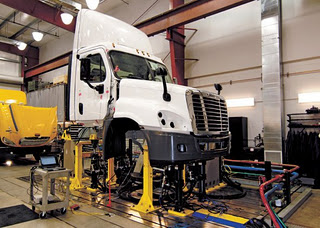 Consolidation characterizes the current business environment in the North American heavy duty truck after-market which continues to witness greater truck complexity, a declining skilled worker population and distribution channel cost compression.
Consolidation characterizes the current business environment in the North American heavy duty truck after-market which continues to witness greater truck complexity, a declining skilled worker population and distribution channel cost compression.Demand for on-road freight hauling continues to rise along with the number of vehicles. The number of class 3-8 commercial vehicles is rising at a CAGR of two per cent and is forecast to top 11.4 million by 2014. “The North American heavy-duty truck aftermarket is faced with a multitude of challenges and opportunities related to service, distribution, consolidation and advanced technology domains,” notes Frost & Sullivan Consultant Mary-Beth Kellenberger. “The future of the aftermarket will depend greatly on the agility shown by market participants to integrate advanced technologies that complement service and maintenance initiatives, reduce downtime, offer greater control on supply chain and distribution flows, and manage inventory.”
Technology drives revenue opportunities in this market and needs to be used extensively to meet the challenge posed by the technician shortage. Advanced diagnostics and prognostics capabilities can help meet service and maintenance demands while also helping to reduce downtime. Technology accelerates the distribution flow and creates standardized operating procedures that increase efficiencies and provide insight into the entire supply chain. Therefore, technology helps to control supply chain variability.
With greater consolidation within the heavy-duty aftermarket parts and service structures, distribution mechanisms and flow channels struggle to cope with downtime and cost issues associated with this change.
“Moreover, original equipment service (OES) channels are amassing a greater share of the aftermarket revenues, driven by the increasing prevalence of proprietary technologies in commercial vehicles. That being said, OES channels are struggling to keep up with demand, thereby offering opportunities for independents to partner with these channels to support their businesses”, noted Frost & Sullivan Program Manager Sandeep Kar.
“In addition, increasing distributed electronic content in commercial vehicles is forcing the need for new technology and equipment acquisitions by product and service providers, in turn inflating product and service costs. There is also a need to streamline the parts distribution structure to improve product and service flow”, he added.
Market conditions demand strategies that provide cost-effective technology integration of the aftermarket distribution system, product development and service flow. Over the short to medium term, consolidations will continue to influence the demand from large fleets. However, independent suppliers and providers of service, maintenance, and parts must retain their interest in small-medium sized fleets and owner-operators who aim to reduce the downtime of their mobile resources.